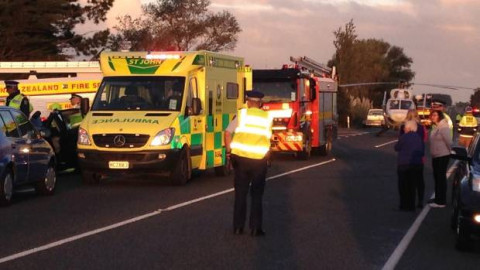
Cut traffic speeds to reduce pressure on hospitals
It’s time to lower traffic speeds to reduce crashes and free up hospital beds, say cycling advocates.
"This will reduce harm and ease the burden on our health workers and emergency services," says Patrick Morgan from Cycling Action Network. "Sadly, traffic crashes are a leading cause of hospitalisation in New Zealand."
"We're calling on the Government to take action now to save lives."
Although there's much less traffic, some travel far too fast.
Why now?
The unprecedented changes we are going through during the pandemic shows how fast people can adapt. In the face of deadly risk, we are working together to prioritise safety and wellbeing, he says.
"This jolt to our habitual lifestyles is a huge opportunity to deliver urgent changes that used to be agonisingly slow."
With most people staying at home, as they should, streets are quiet. Birdsong is noticeable and delightful. The air is cleaner.
"People making fewer journeys in cars is a good thing. But when streets have less traffic, this does not translate into a safer environment for people walking and riding bikes. Wide empty streets invite drivers to increase their speeds."
If the point of the nationwide rāhui is to reduce strain on our health system, New Zealand should immediately cut speed limits - to 80 kmh on open roads and 30 kmh on city streets..
Reducing speeds nationwide would kick start health benefits for all New Zealanders. It would be a strong catalyst for enacting the central principles of the vision zero road safety strategy. And hopefully we will see a sustained reduction in car use.
There are compelling health benefits from safe traffic speeds. Making roads more comfortable for people who choose not to drive should be used as a broad, cost-effective strategy. If more of us choose to walk, scoot and bike we can have neighbourhoods that suffer less air pollution. We’ll be fitter, wealthier people enjoying stronger connected communities and enhanced well being. Cutting traffic is an essential part of a strong climate action response.
The lockdown means many people are in sudden financial strife. Reducing car dependency is an effective way to reduce living costs.
We deserve safe streets. The impact of road trauma on our health system is enormous. Even if traffic crashes are reduced during the lockdown, it would be unacceptable to see road deaths and injuries rebound afterwards.
We need our leaders to direct people to reduce driving speeds during the rāhui. People should expect roads will be used in different ways during this time.
People of all ages and abilities should be able to travel and exercise safely on public streets. There simply isn’t enough space on footpaths to permit required physical distancing, so people are walking on the street. .
"There should at the very least be official messaging for people to keep their driving speeds much lower," says Mr Morgan.
And we should hope they will stay lower forever. We’ll all be better off.
Contact: Patrick Morgan tel 027 563 4733
Cycling Action Network spokesman
Response from Julie Anne Genter, 12 May 2020
Tēnā koe e Patrick,
Thank you for your email of 29 March 2020 regarding reducing speed limits.
Like you, I am extremely concerned by the number of deaths on New Zealand’s roads and since becoming Minister I have heard from many people who share similar views about the dangers of unsafe speeds.
This Government recognises that it has a responsibility to ensure our roads and streets are safe places for people to drive, walk and ride. We know that many crashes are both predictable and preventable and that by creating a safer road environment we can make a real difference in preventing serious and fatal crashes.
Speed continues to be a major contributing factor to deaths and serious injuries on New Zealand roads.
The Government announced last year that it is making changes to speed management to tackle unsafe speeds on New Zealand roads. This includes improving the way road controlling authorities (RCAs), including Waka Kotahi NZ Transport Agency, plan and consult on speed management changes on their roads, reducing speeds around schools, and improving our safety camera network through a new ‘no surprises’ approach to discourage excessive speeds, improve compliance with posted speed limits and reduce deaths and serious injuries.
The Government has taken decisive action to tackle the COVID-19 pandemic, and it is an ongoing priority for us to ensure we reduce the impacts of this pandemic on society. The steps the Government has taken in response to COVID-19 will substantially reduce non-essential travel which is likely to reduce the number of deaths and serious injuries on our roads. At this stage there will be no change to default speed limits on the network, although there will be new requirements for safer speed limits outside all schools.
It is a priority for me that the Government is taking extensive action to improve road safety.
As you know, the Government also released Road to Zero: New Zealand’s new road safety strategy for 2020-2030 at the end of last year. An initial three-year action plan sits alongside the strategy and details the priority actions that the Government will implement, with its partners, as it drives for a 40 percent reduction in deaths and serious injuries by 2030. The strategy and action plan is available on www.transport.govt.nz/zero.
The Tackling Unsafe Speeds programme is a priority action in the final Road to Zero strategy and the first action plan and will play an important role in reducing deaths and serious injuries on our roads.
Further information on the Tackling Unsafe Speeds programme is available at: https://transport.cwp.govt.nz/land/tackling-unsafe-speeds/
Thank you again for taking the time to write.
Nāku noa, nā
Hon Julie Anne Genter
Associate Minister of Transport
